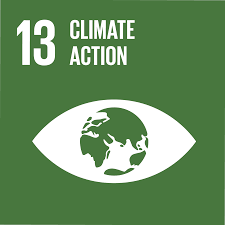Carbon Emissions and its Repercussions
- Rashi Pareek

- Sep 15, 2020
- 4 min read
This article is focused on the following UN Sustainable Development Goal:
SDG 13: Take urgent action to combat climate change and its impacts by regulating emissions and promoting developments in renewable energy
The world is heating up dangerously and humans are the cause of it. If we fail to act today, it will deeply affect the future of the Earth. Climate change is affecting every country on every continent. It is disrupting national economies and affecting all our lives directly. Weather patterns are changing, sea levels are rising, and natural disasters are becoming even more extreme. This is not the new normal we want. Amidst the global health crisis, we may receive news on how the environment is affected positively, but these changes are temporary. It can be easy to forget that this disaster is unfolding, although much more slowly.
Rising carbon emissions and melting of the Arctic ice creates a heat trap. As the Arctic warms, most of the ice disappears, leaving more of the dark ocean to absorb extra sunlight and radiate even more heat, causing even more loss of ice. It’s a vicious cycle that contributes to rapid warming in the region.
Humans are increasingly influencing the climate and the earth's temperature by burning fossil fuels and cutting down rain forests. This adds enormous amounts of greenhouse gases to those naturally occurring in the atmosphere, increasing the greenhouse effect and global warming.
The massive and devastating Amazon forest fire has released pollutants, including particulate matter and toxic gases such as carbon monoxide, nitrogen oxides, and non-methane organic compounds into the atmosphere. The Amazon forest is said to absorb 2 billion tons of carbon dioxide a year. Estimates suggest the fires have produced as much as 140 million metric tons of carbon dioxide. So, in a perverse chain of events, the fires are both generating large amounts of carbon dioxide, while at the same time destroying millions of trees that would be taking in the carbon dioxide and protecting the environment. This problem falls under the UN Sustainable Development Goal 13: Climate action.
The question of what causes colossal amounts of carbon emissions arises-
Burning coal, oil and gas produces carbon dioxide and nitrous oxide.
Cutting down forests (deforestation). Trees help to regulate the climate by absorbing CO2 from the atmosphere. So when they are cut down, that beneficial effect is lost and the carbon stored in the trees is released into the atmosphere, adding to the greenhouse effect.
Fertilizers containing nitrogen produce nitrous oxide emissions.
Fluorinated gases produce a very strong warming effect, up to 23 000 times greater than CO2.
Circling back to SDG 13:
How do we stop fossil fuel emissions? Zeroing out greenhouse gases can be a cumbersome task and it is difficult to find out where to start-
Clean up electric power plants:
Today, roughly one quarter of humanity’s emissions come from power plants that generate the electricity we use for our lights, air-conditioners and factories. Power plants still burn coal, natural gas or oil, producing carbon dioxide that heats the planet.
But there are lots of available technologies that can produce electricity without carbon emissions. France cleaned up its grid with nuclear power. California is aiming for zero-emissions electricity by 2045 by installing solar panels and wind turbines.
Electrify much of our economy:
As our power plants get greener, the next step is to rejigger big chunks of our economy to run on clean electricity instead of burning fossil fuels. Use of battery operated cars and gas burning furnaces with electric heat pumps would help to shift from burning of fossil fuels.
Develop new technology for the hard-to-electrify bits:
Parts of the modern economy can’t easily be electrified. Airplanes and heavy trucks cannot operate on batteries. Heavy industries, like cement or glass, require extreme heat and currently burn coal or gas. About a quarter of emissions fall into this “difficult to decarbonise” side of things. Some possibilities: power airplanes with sustainable bio-fuels from crop waste; usage of green hydrogen, created from renewable energy, to produce industrial heat.
These are some industry-level solutions to curb carbon emissions that would impact multiple economic units as a whole and meet the UN Sustainable Development Goal 13: Climate action, the goal of regulating emissions and promoting developments in renewable energy. What we as students and responsible citizens can do is be aware of how our actions, however small, contribute to carbon emissions. For example, transportation is the biggest source of emission, carpooling or using public transport actively can bring changes. Some lipsticks contain palm oil which is the biggest source of deforestation in Southeast Asia. We can influence our neighbourhoods to install solar panels for energy. Personal actions and international cooperation are inseparable. Drops of water make a mighty ocean, each action counts. Remember, change starts with you.
__________________________________________________________________________________
Works Cited
Anonymous. “Causes of Climate Change.” Climate Action - European Commission, 28 June 2017, ec.europa.eu/clima/change/causes_en#:~:text=Humans are increasingly influencing the greenhouse effect and global warming.
“The Climate Crisis – A Race We Can Win.” United Nations, United Nations, www.un.org/en/un75/climate-crisis-race-we-can-win.
Sengupta, Somini. “Is What I Do Important?” The New York Times, The New York Times, 20 Apr. 2020, www.nytimes.com/interactive/2020/04/19/climate/climate-crash-course-7.html.
__________________________________________________________________________________











Comments